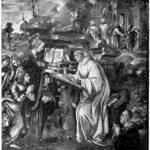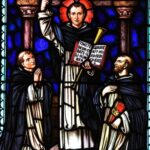St. John Chrysostom
St. John Chrysostom
When They Lived:
St. John Chrysostom, also known as John of Antioch, lived during the late 4th and early 5th centuries. He was born around 349 AD and died in 407 AD.
Where They Lived:
St. John Chrysostom was associated primarily with the city of Antioch, which was a significant center of early Christianity located in present-day Turkey. He later became the Archbishop of Constantinople, which is modern-day Istanbul in Turkey.
Notable World Events During Their Time:
- The Sack of Rome (410 AD): In 410 AD, the Visigoths, led by King Alaric, sacked Rome. This event shook the Roman world and marked a symbolic decline of the Western Roman Empire.
- The Council of Nicaea (325 AD): This significant ecumenical council shaped early Christian doctrine and defined important aspects of the faith.
- The Fall of the Western Roman Empire (476 AD): After Chrysostom’s death, the Western Roman Empire finally fell, marking the end of ancient times.
- The Writing of the Codex Theodosianus (438 AD): This compilation of Roman laws had a lasting impact on legal systems and governance in the later Roman Empire.
- The Completion of the Hagia Sophia (360 AD): The Hagia Sophia’s construction was a remarkable architectural achievement in Constantinople during his lifetime.
- The Arrival of the Huns (4th-5th century): The migration of the Huns influenced the geopolitical landscape of Chrysostom’s time.
- The Writings of Augustine of Hippo (354-430 AD): Augustine’s theological and philosophical works greatly shaped Western Christianity.
Their Patronage:
St. John Chrysostom is recognized as the patron saint of preachers, speakers, and educators. His eloquent and passionate style of preaching earned him the title “Chrysostom,” which means “golden-mouthed.”
The Sickly Hermit
St. John Chrysostom was born in Antioch around the year 347. His father died when he was still young, and his mother guided his education. John was an excellent student of his time. He studied classical Greek education and rhetoric. When he was 18 years old, upon meeting the holy Bishop Meletus, he experienced a religious conversion and started to study the Scriptures.
Three years after his studies, John was baptized. He joined a group of monks in the mountains. He left them and lived in a cave as a hermit. There, he stayed for prolonged hours of prayer and practiced extreme mortifications. However, these practices left him in poor health. Thus, he returned to Antioch and devoted himself to studying for the priesthood. In 386, John was ordained a priest.
The Great Preacher
John served the Cathedral of Antioch for 12 years. He gained widespread popularity due to his intelligence, but most especially his gift of preaching. In 398, he was elevated to the rank of Patriarch of the See of Constantinople. Though with much hesitation, John accepted the responsibility.
As the bishop-patriarch, John was very different from other bishops in his time. He lived a life of simplicity. He gave his wealth to build hospitals. He set about reforming the clergy and the city. He deposed bishops for buying their way into office. He attacked wealthy people for the misuse of their money and possessions. John exerted a lot of effort to reform the lax clergy, correct the badly managed budget, and eradicate the land of violence.
The bishop-patriarch became very popular with the people through his outstanding example of preaching and courage in front of the imperial power. He never avoided publicly criticizing the corruption and luxurious indulgence of those in power. He was not afraid to preach justice in the light of the Gospel. In matters of justice and charity, John acknowledged no double standards.
Condemned and Banished
His attitude and zeal for charity and justice naturally made him an adversary of the Empress Eudoxia and provoked the jealousy of Theophilus, the Patriarch of Alexandria. Fearing the growing importance of John, Theophilus took the occasion to charge him with fostering heresy. Theophilus and other exasperated bishops were supported by the empress. In 403, false charges were thrown against John. He was impeached, condemned, and sentenced to be exiled in Armenia. He continued to be a great presence in the Church of the East through his numerous letters.
Pope Innocent I supported John. However, despite the pontiff’s support, John was exiled even farther away. His enemies were not satisfied with the sufferings he had already endured, and they banished him still further to the very extremity of the empire. From Armenia, John was exiled to an isolated place along the Black Sea. Due to his failing health and inability to endure the rigors, John died during the journey in 407 in Pontus. His feast day is September 13.
Five Interesting Facts About St. John Chrysostom
- “Chrysostom” in St. John Chrysostom comes from the Greek “chrysostomos”, which means “golden-mouthed”. This was because of his eloquence in preaching.
- St. John Chrysostom is the patron saint of preachers and orators.
- In 438, Emperor Theodosius II of Constantinople had St. John Chrysostom’s body returned to Constantinople and did penance for the sins of Eudoxia, his mother.
- St. John Chrysostom was declared a Doctor of the Church. Along with St. Basil the Great, Gregory of Nazianzus, and Athanasius, St. John Chrysostom is considered one of the greatest of the early Eastern Church fathers.
- Aside from the Roman Catholic Church, the Orthodox Church, and Eastern Catholic Churches, the Church of England and the Lutheran Church also honor John Chrysostom as a saint.
Prayer to St. John Chrysostom
O God, strength of those who hope in you, who willed that the Bishop Saint John Chrysostom should be illustrious by his wonderful eloquence and his experience of suffering, grant us, we pray, that, instructed by his teachings, we may be strengthened through the example of his invincible patience. Through our Lord Jesus Christ, your Son, who lives and reigns with you in the unity of the Holy Spirit, one God, for ever and ever Amen.



